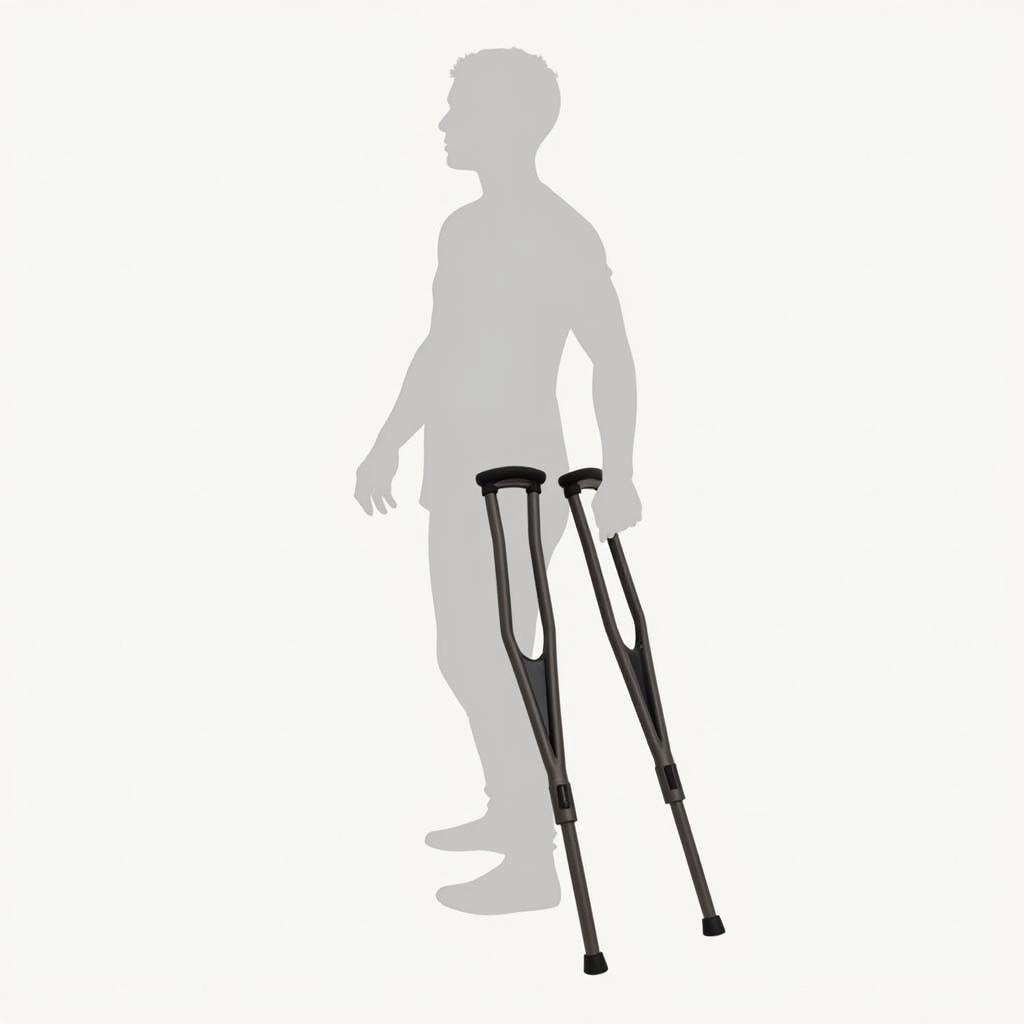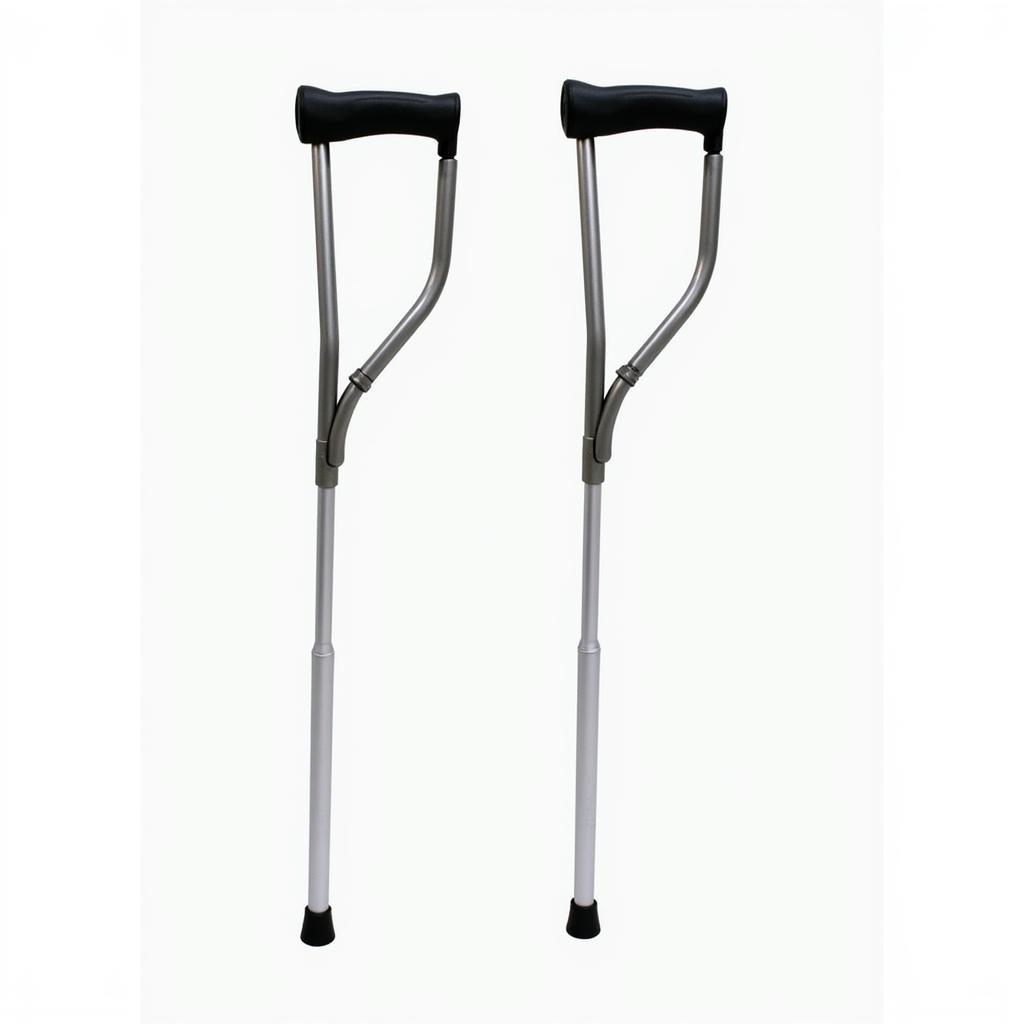Crutches for Tall People: Finding the Right Fit
November 2, 2024Finding the right crutches can be a challenge, especially for taller individuals. Properly sized crutches are crucial for comfort, stability, and preventing further injury. This guide will help tall people navigate the world of crutches, ensuring they find the perfect fit for their unique needs.
Why Crutch Height Matters for Tall People
Using crutches that are too short can lead to a hunched posture, putting strain on your back, shoulders, and wrists. Conversely, crutches that are too tall can cause pressure under your arms, leading to nerve damage and discomfort. For tall individuals, finding that Goldilocks “just right” height is even more critical. It can be the difference between a smooth recovery and a painful, frustrating experience. The right crutch height allows for a natural, upright posture, distributing weight evenly and minimizing strain.
 Tall person demonstrating correct crutch height
Tall person demonstrating correct crutch height
Measuring for Crutches: A Step-by-Step Guide
Proper measurement is key to finding the perfect crutch fit. Here’s a simple guide:
- Shoes On: Wear the shoes you’ll typically wear while using crutches.
- Upright Posture: Stand tall with your arms relaxed at your sides.
- Handgrip Placement: Your handgrips should be at wrist level when your elbows are slightly bent (about 15-20 degrees).
- Crutch Placement: Position the crutches two inches below your armpits and slightly wider than your shoulders. There should be a two-finger gap between your armpit and the top of the crutch.
- Measuring: Measure the distance from the top of the crutch to the ground. This is your ideal crutch height.
Crutch Styles for Tall People
While underarm crutches are common, forearm crutches (also known as Lofstrand crutches) can be a more comfortable and maneuverable option, particularly for long-term use. Forearm crutches offer better weight distribution and greater freedom of movement. For taller individuals, adjustable forearm crutches are ideal, allowing for precise height customization.
Tips for Using Crutches as a Tall Person
Navigating stairs, uneven terrain, and doorways can be tricky with crutches. Here are a few tips:
- Take small steps.
- Maintain a stable base.
- Use handrails whenever possible.
- Plan your route to avoid obstacles.
“For taller individuals, investing in crutches with robust construction and adjustable features is crucial for long-term comfort and stability,” says Dr. Emily Carter, a physical therapist specializing in rehabilitation.
Common Crutch Problems for Tall People and Their Solutions
One common issue tall people face is the standard crutch height not being sufficient. Luckily, many manufacturers offer extended-length crutches specifically designed for taller individuals. These crutches provide the necessary height adjustment for a comfortable and safe experience. Another problem is handgrip discomfort. Adding padded handgrips can greatly improve comfort and reduce the risk of blisters and calluses.
 Adjustable forearm crutches with padded handgrips suitable for tall individuals
Adjustable forearm crutches with padded handgrips suitable for tall individuals
“Remember, proper crutch fit is essential for a smooth recovery,” adds Dr. Michael Johnson, an orthopedic surgeon with over 20 years of experience. “Don’t hesitate to consult with a healthcare professional for personalized advice.”
Conclusion
Finding the right Crutches For Tall People involves careful measurement, consideration of different crutch styles, and understanding how to use them effectively. By following these guidelines, taller individuals can ensure a comfortable and safe recovery, allowing them to regain their mobility with confidence.
FAQ
- What is the ideal crutch height for a tall person? There is no single ideal height. It depends on individual measurements, following the guidelines outlined above.
- Are forearm crutches better for tall people? Forearm crutches can offer better mobility and weight distribution, especially for long-term use.
- Where can I find extended-length crutches? Many medical supply stores and online retailers offer extended-length crutches.
- How do I adjust the height of my crutches? Most crutches have push-button adjustments. Consult the manufacturer’s instructions for specific guidance.
- What should I do if I experience pain while using crutches? Consult with a healthcare professional to assess your crutch fit and usage technique.
- Can I use crutches while navigating stairs? Yes, but take precautions and use handrails whenever possible.
- How do I choose between underarm and forearm crutches? Consult with a healthcare professional to determine the best option for your specific needs and injury.
Common Scenarios
- Scenario 1: A tall basketball player injures their ankle and needs crutches for a few weeks. They should consider adjustable forearm crutches for better mobility and maneuverability.
- Scenario 2: A tall individual with a long-term mobility issue requires crutches for everyday use. They should prioritize comfort and stability by choosing well-padded, adjustable crutches and consulting with a physical therapist for proper usage techniques.
Related Articles and Questions
- Crutch Exercises for Strengthening
- Choosing the Right Mobility Aids
- How to Prevent Crutch-Related Injuries
Need support? Contact us 24/7: Phone: 0963418788, Email: [email protected] or visit us at 2M4H+PMH, Phường Nghĩa Thành, Gia Nghĩa, Đắk Nông, Việt Nam.